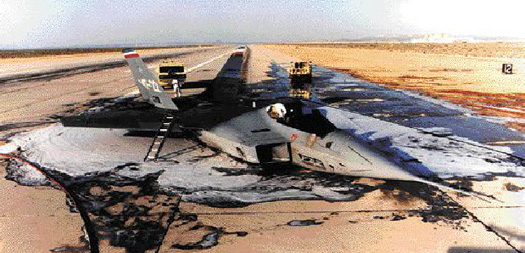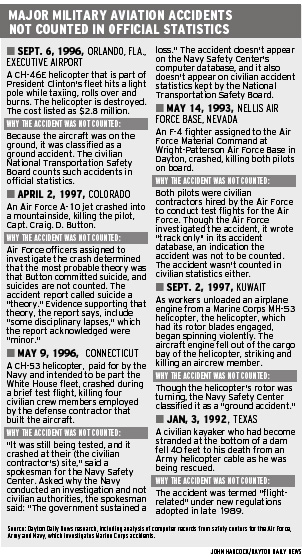Official statistics mask
actual number of crashes
Even deadly accidents may not be counted
 AIR FORCE SAFETY CENTER
AIR FORCE SAFETY CENTERBECAUSE THE JET WAS experimental, this crash of a YF-22 fighter on April 25, 1992, at Edwards Air Force Base, Calif, was not counted in the official Air Force accident rate. The jet belonged to a command headquartered at Wright-Patterson Air Force Base. |

|
©1999 Dayton Daily News
Two pilots were killed and a $2.3 million aircraft was lost when an F
4G fighter belonging to the Air Force Material Command at Wright
Patterson Air Force Base crashed near Las Vegas on May 14, 1993.
Footage of the burning jet topped the evening news in Las Vegas, but the crash wasn't included in the official Air Force accident rate that year.
 A Sept. 9, 1996, accident in Orlando, Fla., destroyed a $2.8 million military helicopter assigned to the White House.
A Sept. 9, 1996, accident in Orlando, Fla., destroyed a $2.8 million military helicopter assigned to the White House.
The crash made the top of the Pentagon's press briefing that day, and President Clinton called for an investigation into the safety of aircraft assigned to his fleet. But when the Navy released its official accident rate that year, the accident was not included.
These are among hundreds of aviation incidents since 1980 that the armed services did not calculate in official accident rates, statistics used by Congress and the public to assess military aviation safety.
An 18-month Dayton Daily News examination found that among those not counted were at least 282 Class A and B accidents -- the type watched most closely by Congress -- that killed at least 78 people and injured another 130.
And several times during the past 10 years, as the military boasted that its aviation accident rate had declined, the number of accidents omitted from official statistics grew. The percentage of accidents not counted increased from 5.6 percent of total accidents in 1990 to 23 percent in 1997 -- nearly one of every four incidents.
At least part of the reason the services were able to conceal the incidents from the public, the newspaper's examination found, is that military rules for reporting aviation incidents are vague, leaving commanders wide discretion in determining which accidents will be counted.
The Daily News discovered the uncounted accidents in three previously unreleased computer databases obtained through the federal Freedom of Information Act. Though the Army, Air Force and Navy, which investigates Marine Corps accidents, included all but a few of the incidents on the databases, special codes prevented them from appearing on records provided to the public.
"There is zero intent to hide anything," said Brig. Gen. Gene Martin LaCoste, commander of the U.S. Army Safety Center at Fort Rucker, Ala.
Rear Admiral Frank M. "Skip" Dirren, Jr., who commands the Naval Safety Center in Norfolk, Va., said, "I'm not trying to hide anything."
Both LaCoste and Dirren said they are following rules given them by the Department of Defense.
Sections: 1 2 3